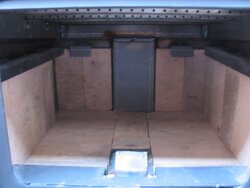I think you will like your 30NCH, mine has been a good stove - one year under the belt with it. The pedestal set-up definitely makes for easier moving with the dolly IMHO.
The only stove that was easier to move was the Encore and that was because I completely dissembled it. I was surprise that the stove was not bolted to the pallet. Kind of figured it would have been.
The large firebox holds a lot of wood too. We can obliterate a wheel bar of wood in the 30 without any real effort.
Well, now, that's not what I want to hear!

Seriously, though, I know what you mean. But, for the most part, I will not be using the stove at maximum capacity. During the day it will probably be less than half full. Two to four splits maybe. Not sure about the overnight burns, yet. I will need to see how much the mass of the stove plays into heating the area.
The challenge will be to not roast my self out of the room. Not too concerned about it. But, it will be something I will need to play with.
FWIW, my 30 gets up to temperature very quickly and once I hit around 525ish, I get a smoke free burn. Generally, temps below that and I start seeing smoke. I like the ash pan on my stove, for me, it's just not as messy using the ash pan. I played around with closing the two air inlets that feed the dog house, but in the end just burn this stove as it came from the factory. I have never had an overfire and being a steel stove, have no fears of cracking or breaking anything. Pretty much, load the stove and let it rip.
The simplicity of the stove was one of the reasons I went with it. I just wanted something I could throw wood in, cut the air back, and walk away.
I have tried loading the stove N/S and E/W and prefer N/S. I think I get a longer burn E/W and it's harder to smash one of the burn tubes loading E/W as you don't have the blunt end of a split perpendicular to a tube.
I've seen it mention that a longer burn will be had from E/W. I wonder what the burn time difference will be?
Even though my 30 is in a new insulated basement, that basement is attached to my older drafty house and there are doors into the old house - one via new to old basement door opening and the other is stairwell beside to the old house. As such, the old structure pulls a lot of heat from the 30's output and dumps a lot of cool air back into the basement. The result is I'm not capturing much heat in my house once it's produced. So across the burn cycle, I'm burning more wood trying to keep an even temperature. I find we are loading the stove about every 4 hrs if we want to maintain temperatures.
Wow, every four hours? I can relate to the draftiness and the frustration from getting shorter burn times due to this. I know I am clearly the last one to talk about insulation, but, you would think you would greatly benefit from that just so you don't have to load a stove so often.
I do feel confident that I will get about 10 hours of useable heat from the stove due to the fact that I am over-sizing the hell out of it.
Each stove needs to heat about 700 sq ft. If these three stoves can't handle it, I need to check and see who stole my roof...

)




